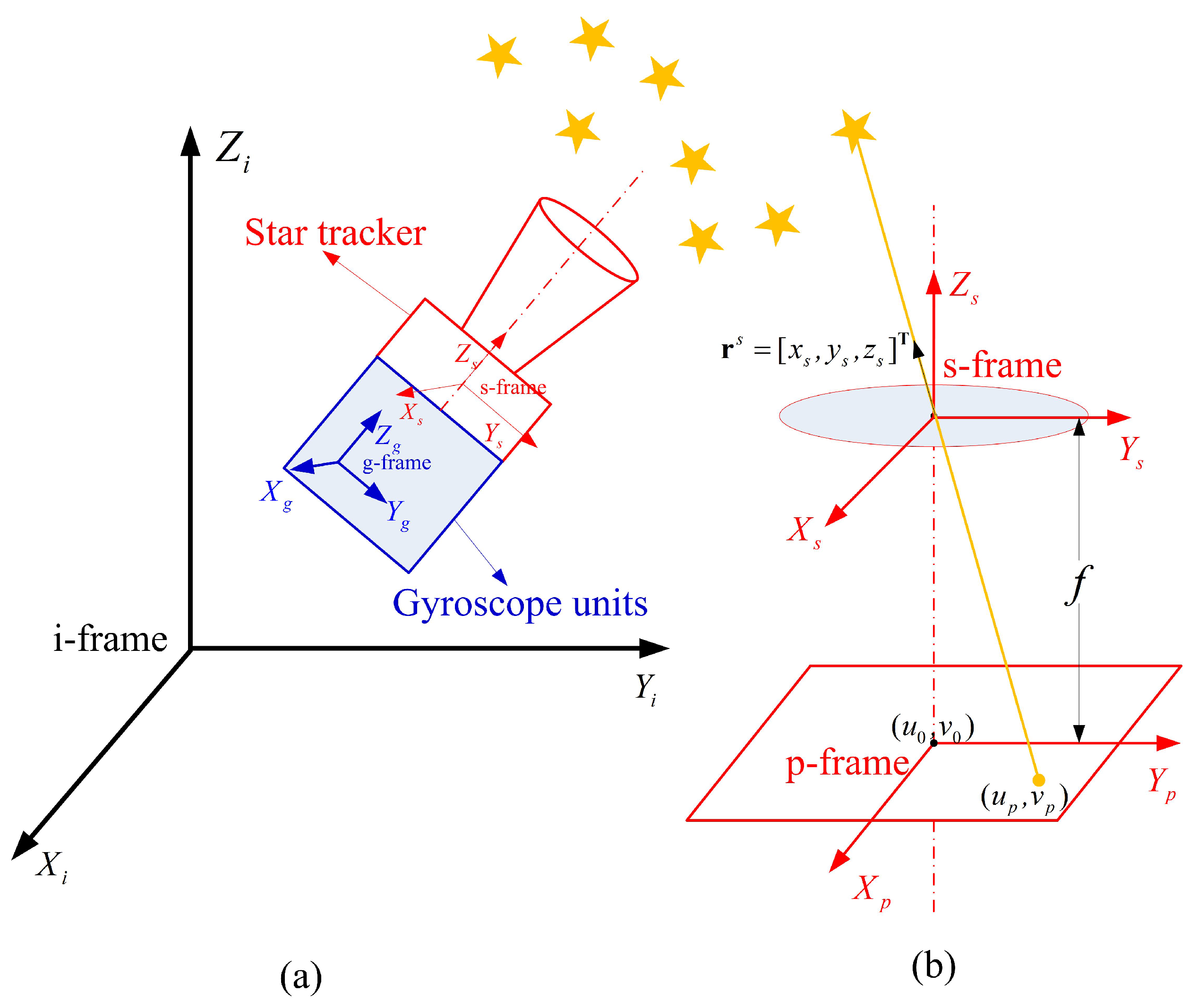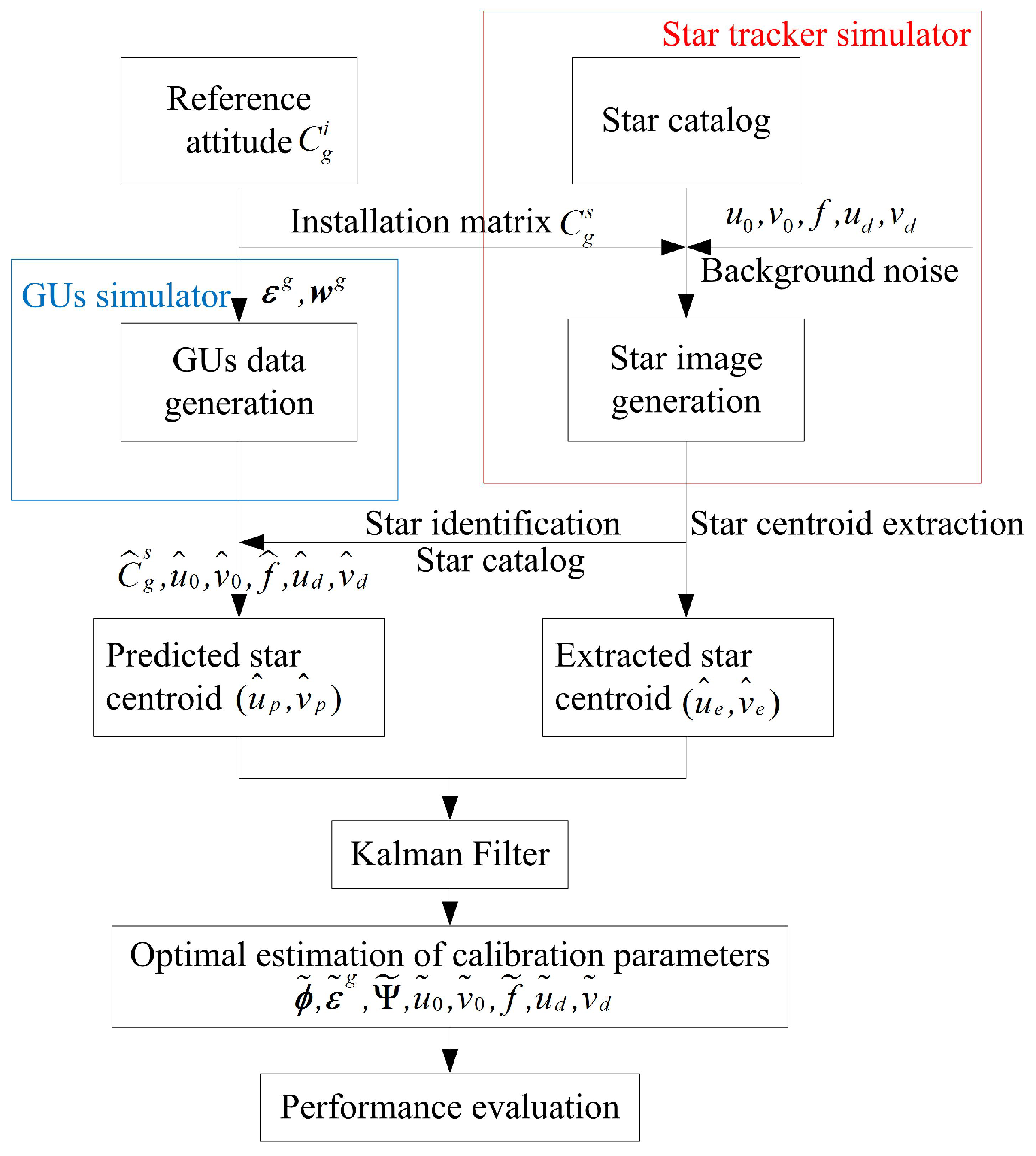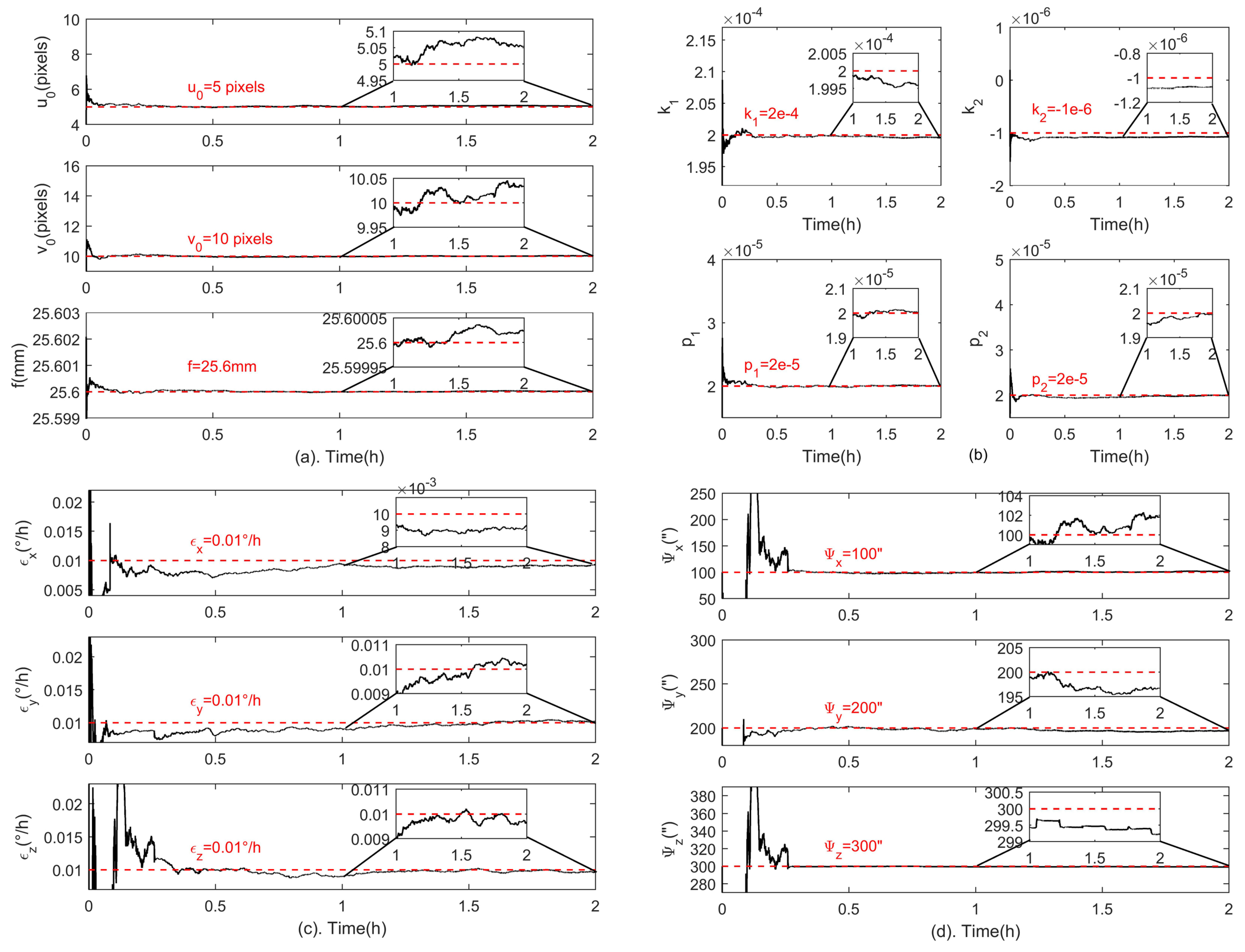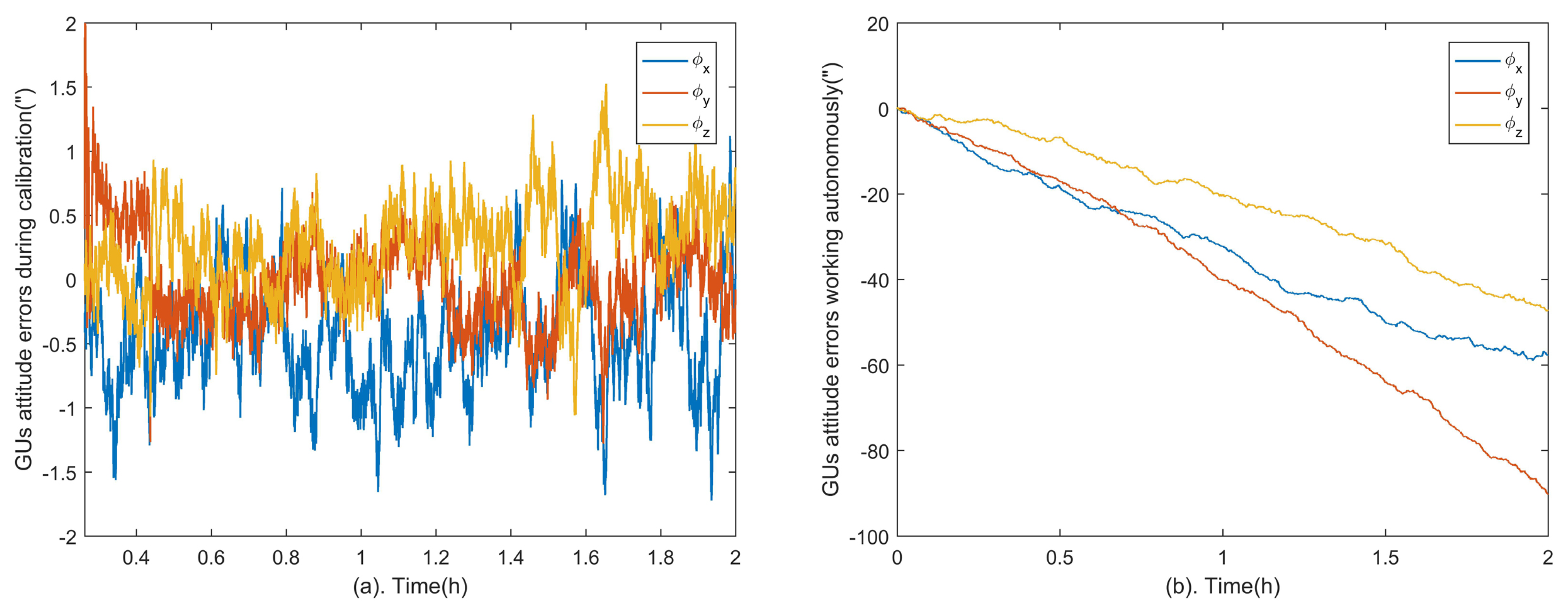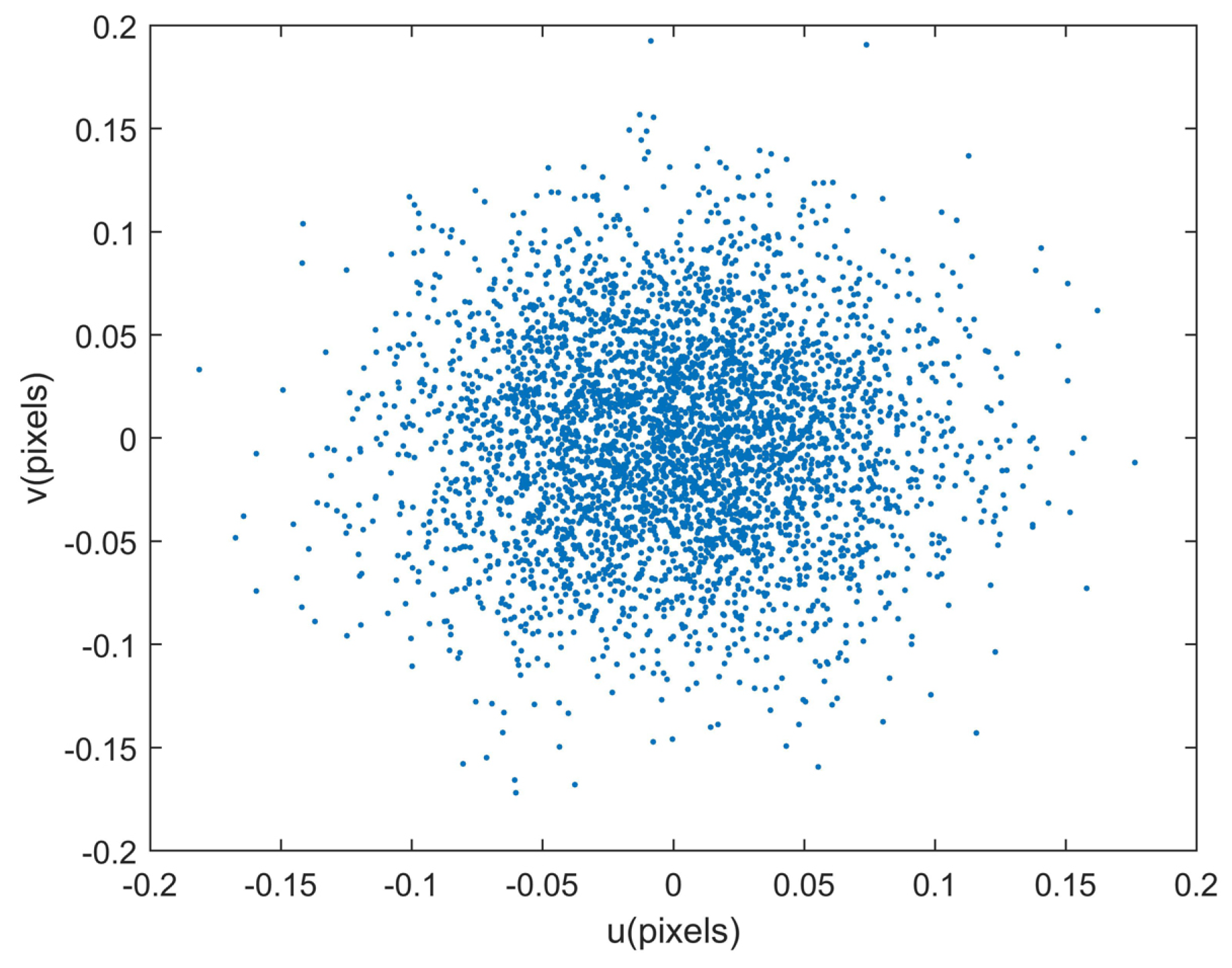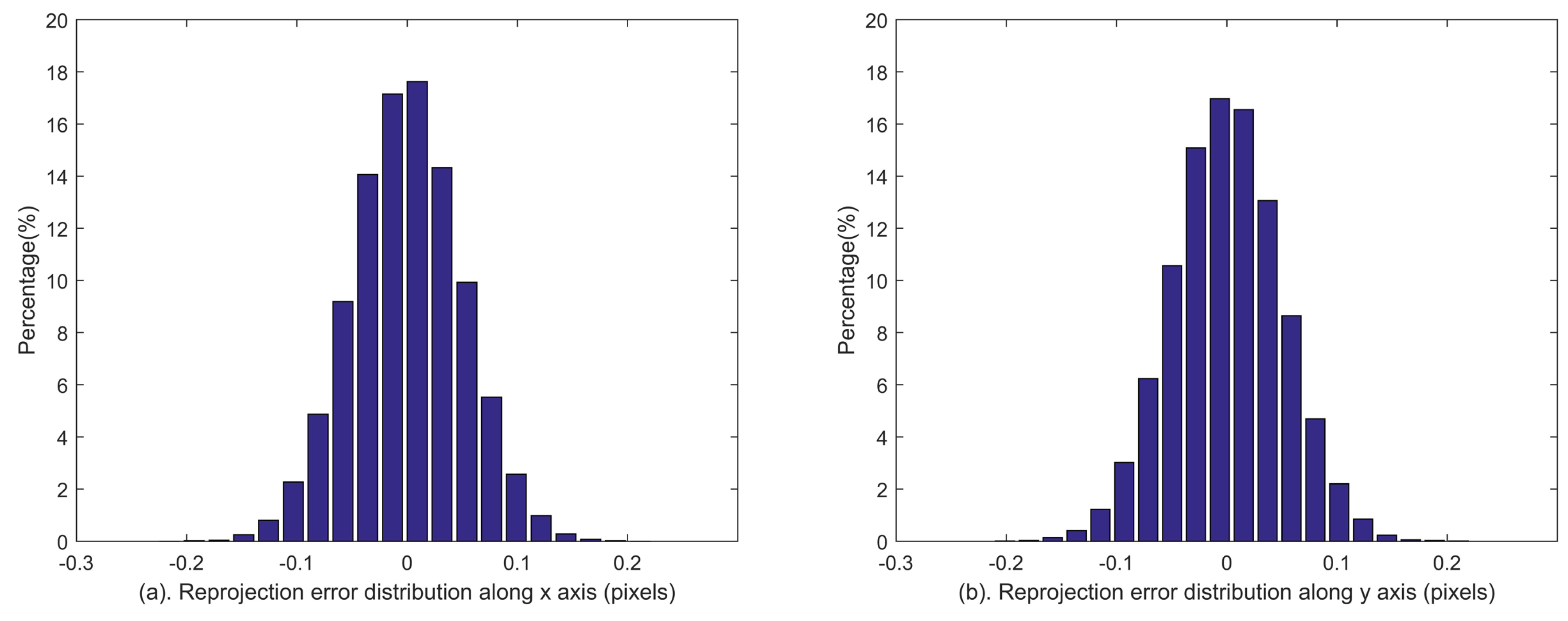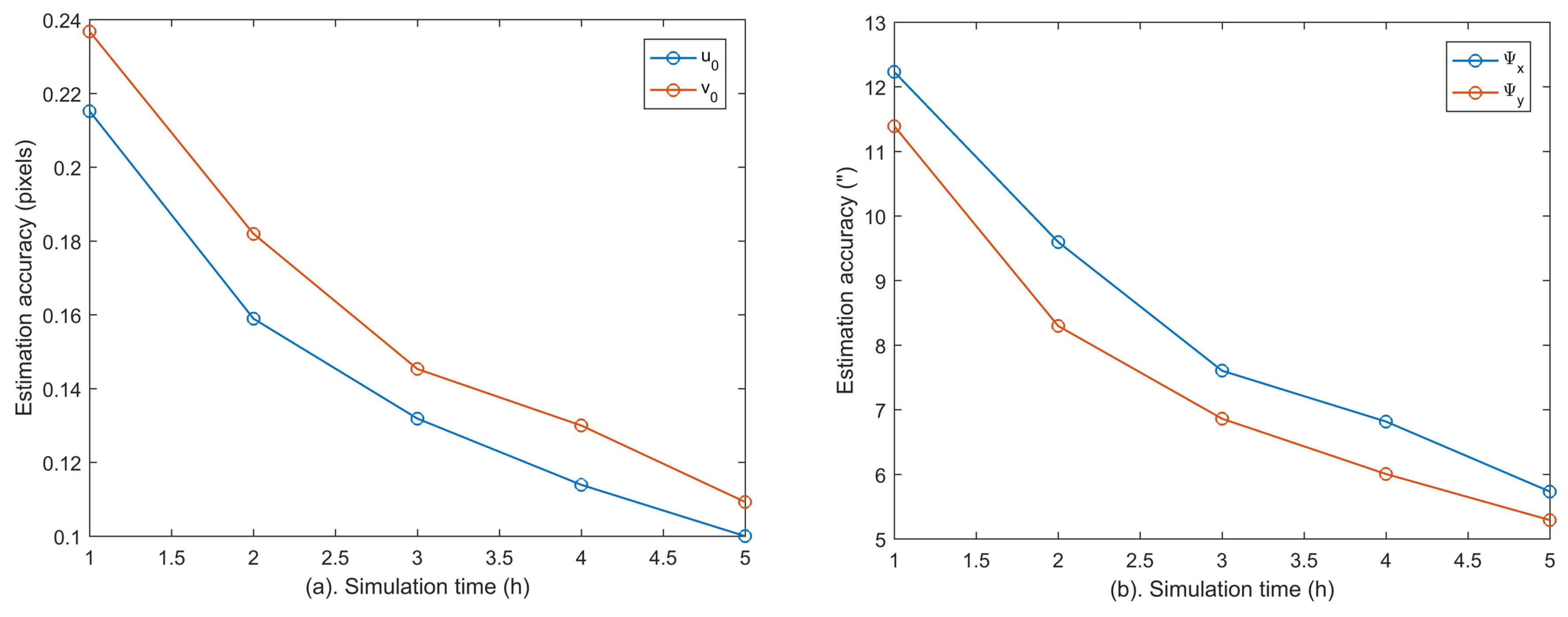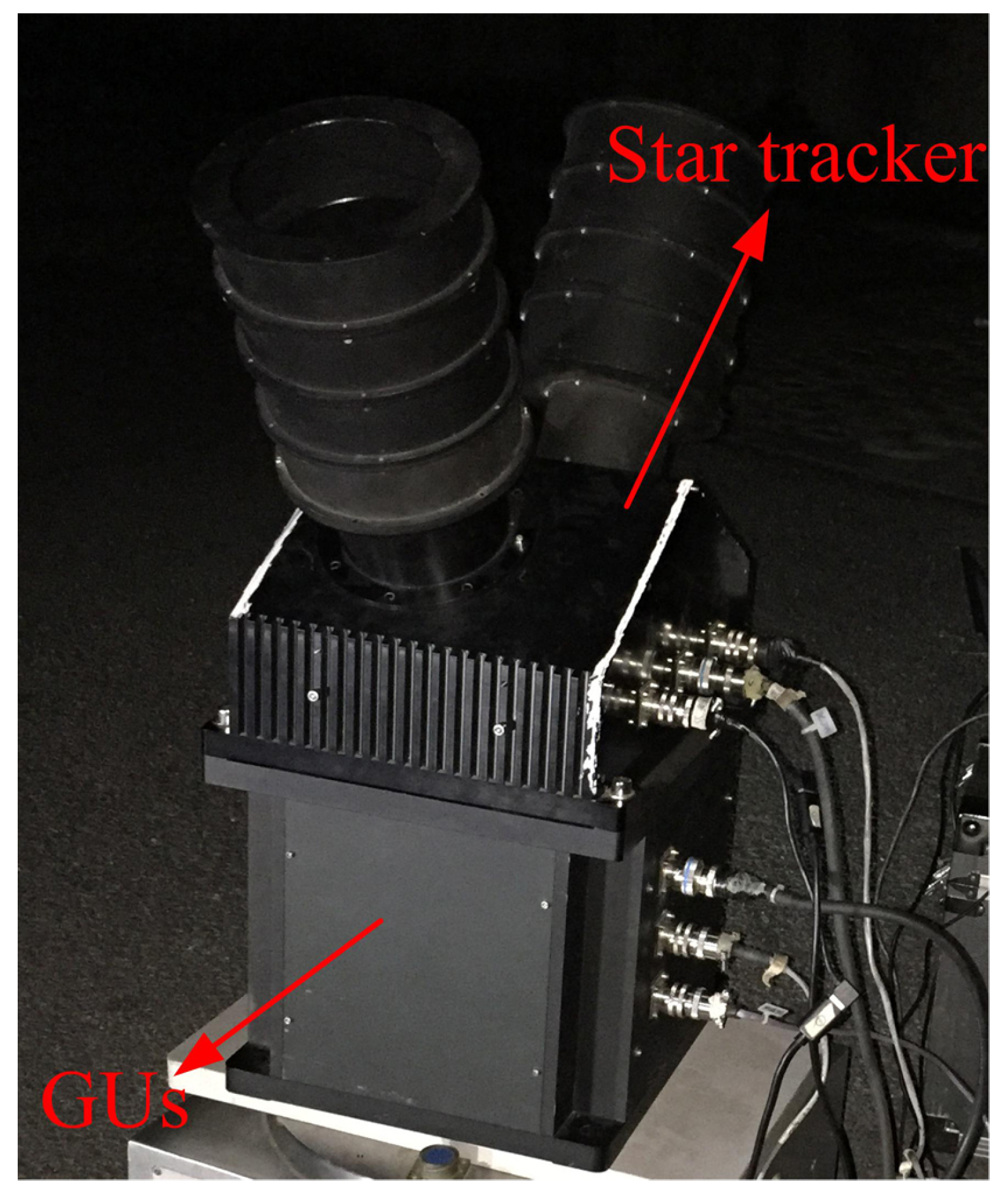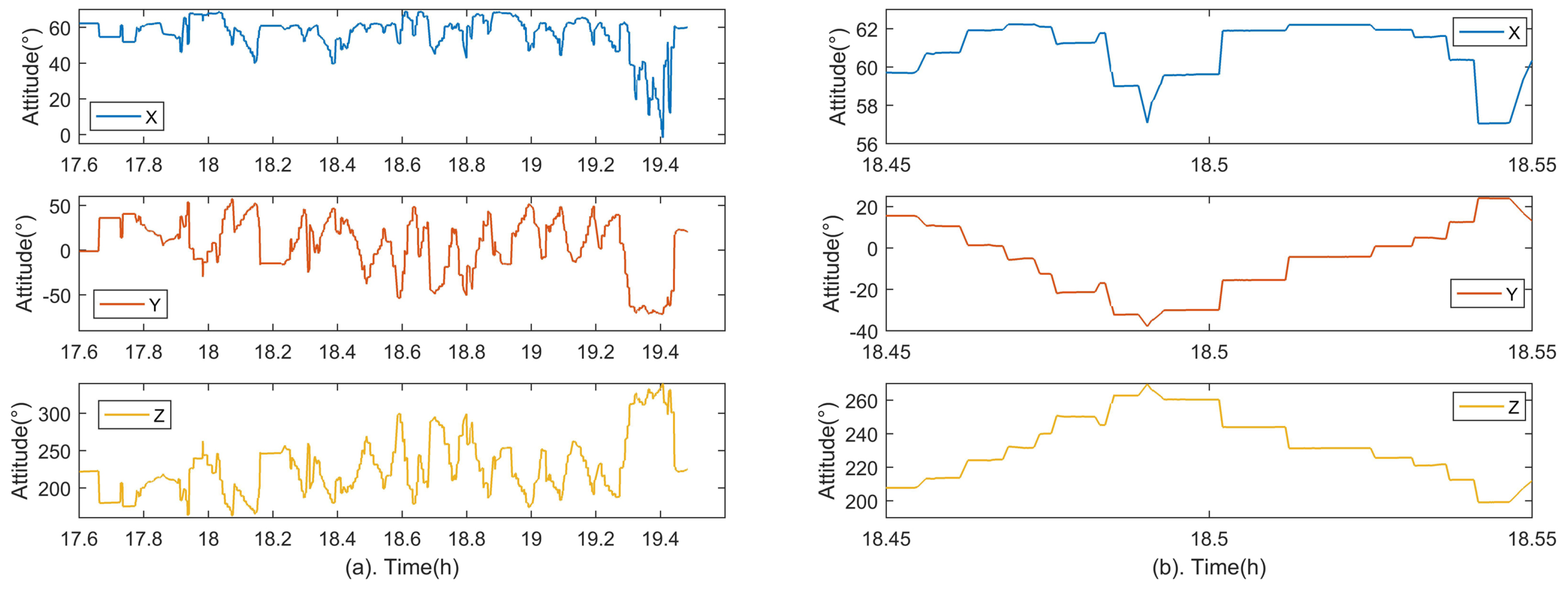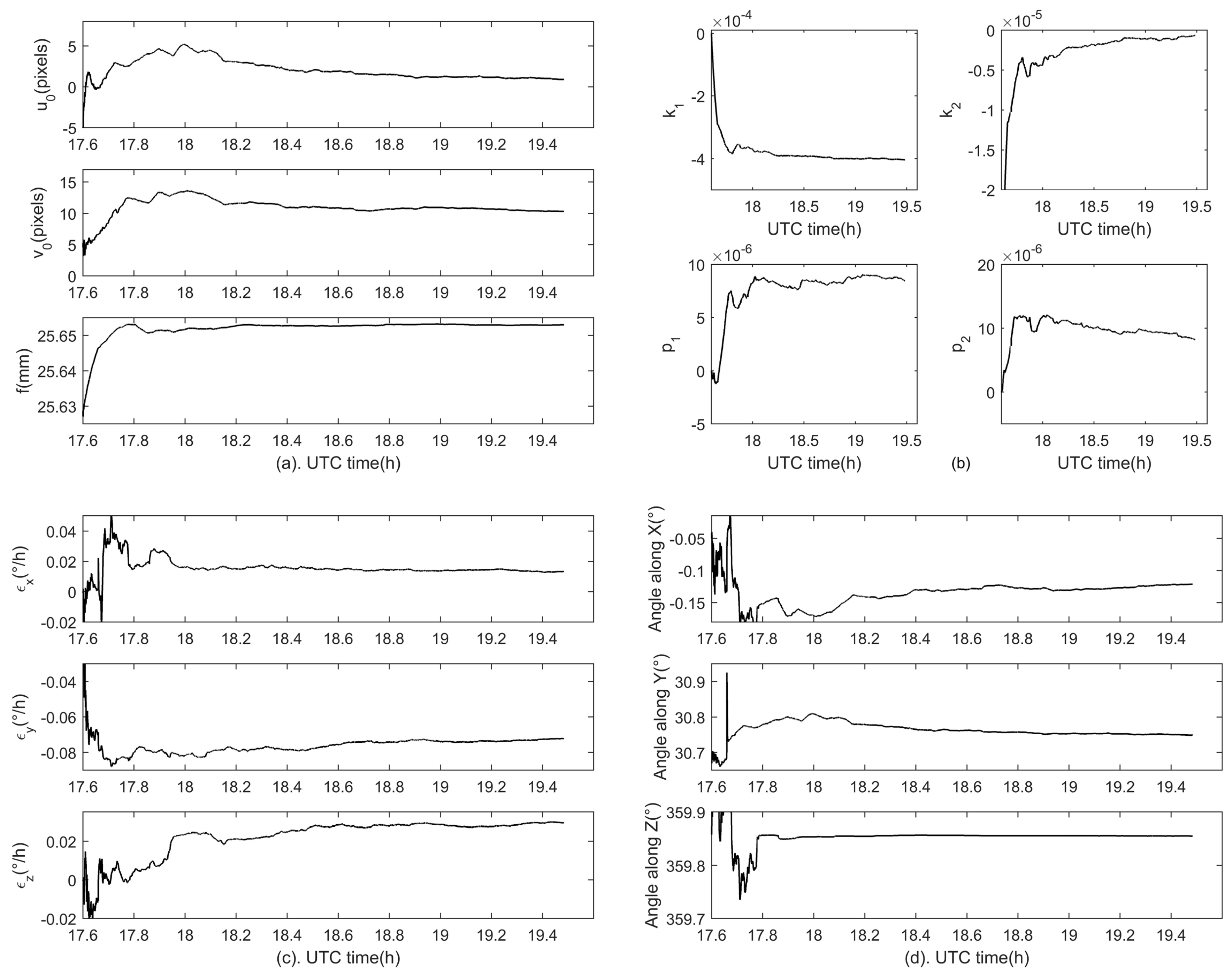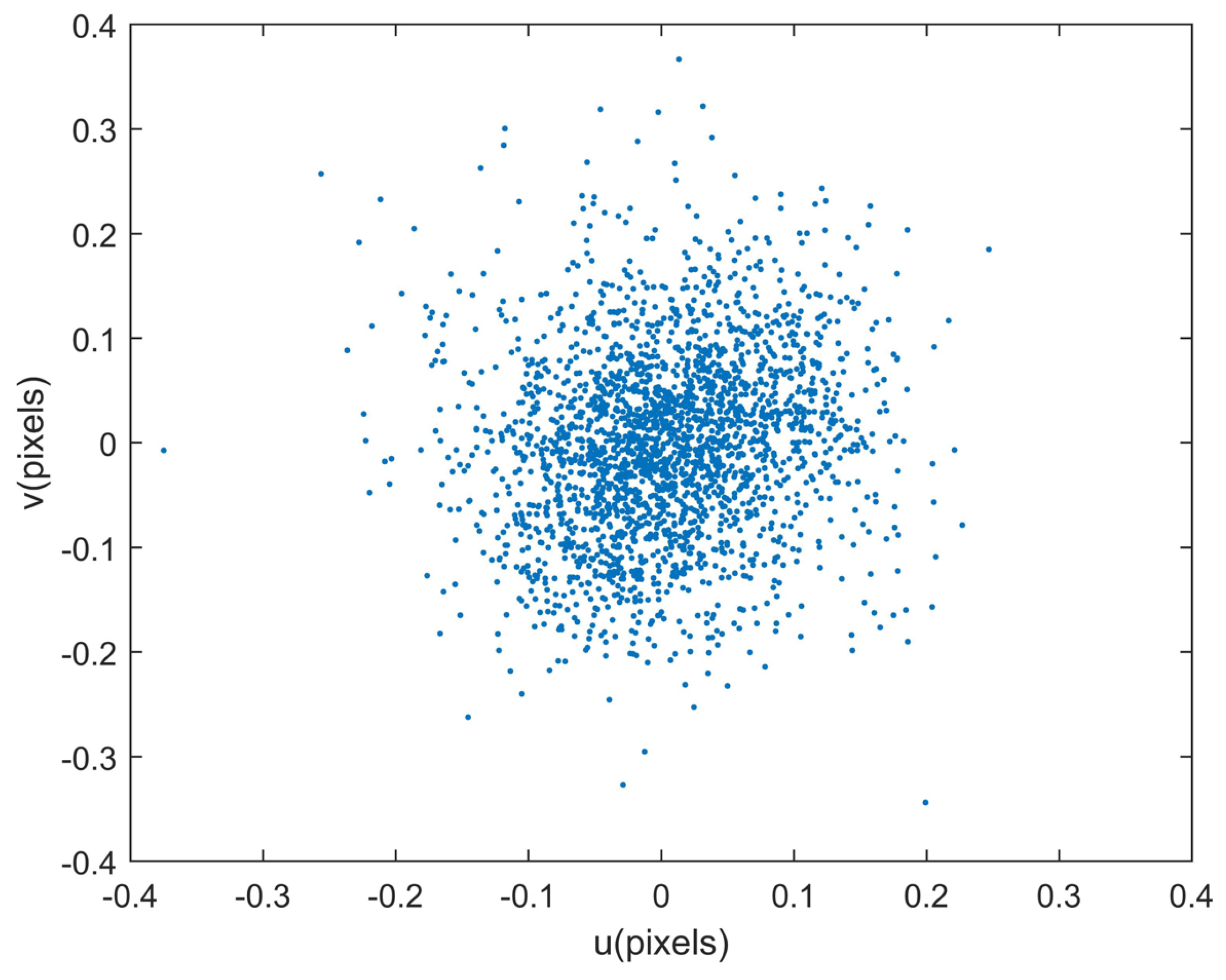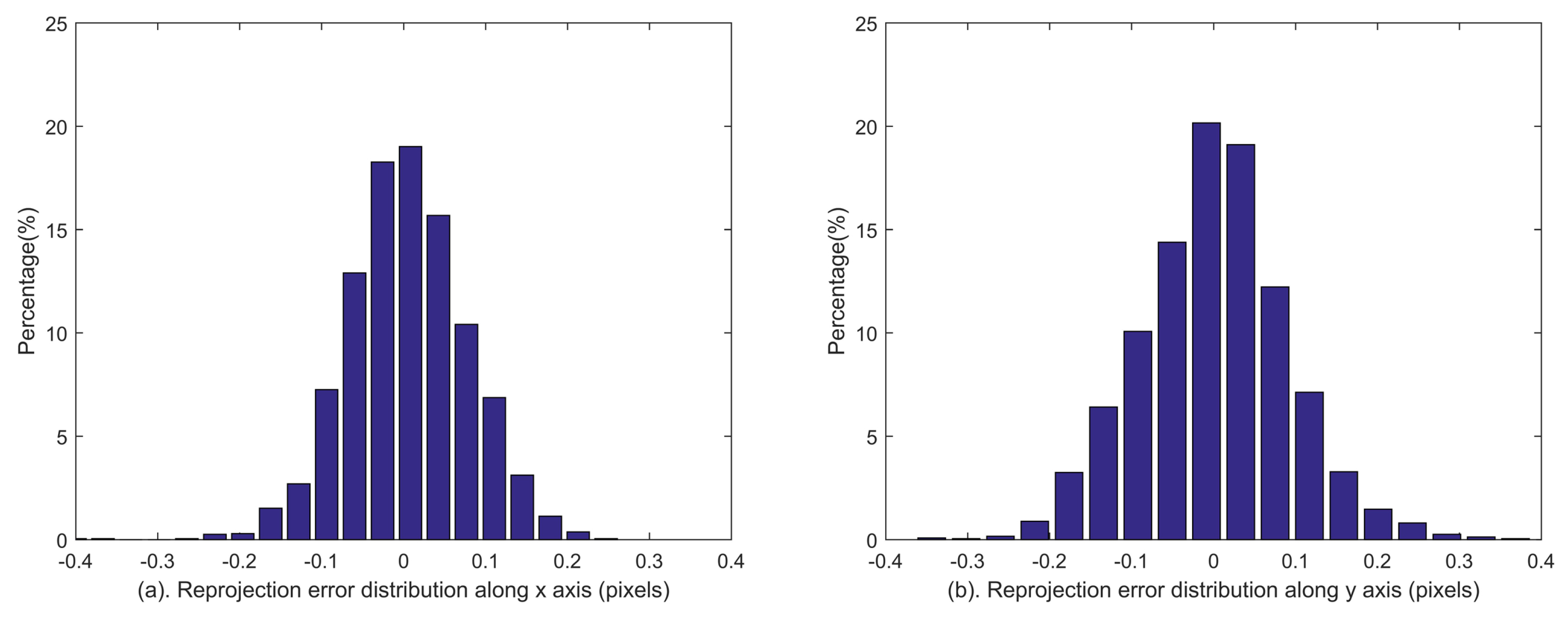Several groups of simulations are designed to verify the feasibility of the proposed method. The procedure for each simulation is given in
Figure 2. The star tracker simulator can generate corresponding star images with true model parameters
and the preset reference attitudes
. The ESC
can be obtained with the centroid extraction algorithm. Simultaneously, the GUs simulator can generate the three-axis angular rate of the GUs, which is sequentially used to calculate the PSC
with parameters
contaminated by errors. Then the systematic errors are estimated with the proposed method with a Kalman Filter. The performance evaluation is conducted by: (1) comparing the estimated model parameters with preset true values; (2) comparing the estimated attitudes with preset reference attitudes; (3) calculating the reprojection error with estimated parameters.
3.1. Simulation Using Proposed Method
A typical star tracker and gyroscopes of navigation grade are used for this simulation with performance specifications listed in
Table 1. The rotation sequence of the integrated system for calibration is shown in
Table 2 and will be repeated during the whole calibration process.
Then, the proposed method is applied to the simulated data, and
Figure 3 shows estimations of all systematic errors. The black and red lines indicate the estimation results and the preset true values of the calibration parameters, respectively. Specifically,
Figure 3a shows estimations for the principal point
and the focal length
f,
Figure 3b for lens distortion coefficients
,
Figure 3c for the gyroscope bias and
Figure 3d for fixed angle errors. The final calibration results are also listed in
Table 3. It is shown that the estimations of all systematic errors are very close to the preset true values. The estimation error of the principal point is
pixel, the focal length error is 0.00002 mm, the gyroscope bias estimation errors are
/h for the three gyroscopes, and the estimation errors of fixed angle errors are (1.8, 3.3, 0.8)” in three directions. The lens distortion error on the detector plane is shown in
Figure 4. The distortion error at the edge of the detector is reduced from 3 pixels to 0.032 pixel when the proposed method is applied.
In this calibration method, the role of the GUs is equivalent to the precision turntable of the laboratory-based calibrations. The GUs cannot keep high precision for a long time while working autonomously due to the cumulative error of gyroscopes. However, the GUs errors can be estimated and restrained by the star tracker through the proposed method.
Figure 5a shows the attitude errors of the GUs in three axes. The convergent attitude accuracy is calculated from time epoch 1 h to 2 h, which are
(Root Mean Square, RMS) in
axes respectively. Compared to the attitude errors of GUs without the aid of the star tracker shown in
Figure 5b, the cumulative error is eliminated and the accuracy is improved significantly. In other words, the GUs can serve as an accurate three-dimensional turntable in the calibration.
Given the estimated calibration parameters, the identified stars can be reprojected to the image plane. The reprojection errors [
27], which are defined as the deviations between the reprojected star coordinates and the extracted ones, reflect the calibration accuracies of all systematic errors synthetically. The reprojection errors are calculated during the last 10 minutes of the simulation, which are shown in
Figure 6. The distributions of reprojection errors are shown in
Figure 7. The statistical reprojection accuracy is (0.05, 0.05) pixel (RMS) in the two directions of the image plane, which is almost the same as the preset centroid accuracy. It is shown that the reprojection errors induced by the systematic errors of the star tracker and GUs integrated system are remarkably reduced, which means the proposed method can achieve accurate calibration results.
3.2. Performance under Different Star Centroid Accuracies
The star centroid accuracy is one of the main factors affecting the calibration accuracy, and it differs under different noise levels of the detector. Simulations under different centroid accuracies are conducted in this section. The centroid accuracy is sequentially set to 0, 0.05, 0.10, 0.15, and 0.20 pixel, and other performance specifications of the star tracker and GUs are kept the same as in
Section 3.1. For each star centroid accuracy, 100 random simulations are carried out. The calibration accuracy of each parameter is evaluated by the RMS value of estimation errors, and the statistical results are listed in
Table 4.
From the statistical results under different centroid accuracies, it can be seen that the gyroscope bias estimations are scarcely affected by the centroid errors. Although the calibration accuracies of distortion coefficients are slightly affected, the maximum distortion can still be acceptably controlled below 0.035 pixel at the edge of the detector even when the centroid error reaches 0.20 pixel. Similarly, the calibration accuracy of the focus length can still reach 0.00027 mm when the centroid error reaches 0.20 pixel, which is accurate enough for the application of the integrated system. The influence of the centroid error mainly focuses on the estimations for the principal point
and subcomponents of fixed angles
due to the coupling between them, which will be analyzed in
Section 3.4. Their estimation accuracies decline with increasing centroid error. Generally, the centroid accuracy of the star tracker is high enough (e.g., better than 0.10 pixel for the star tracker in our laboratory) during calibration, and high calibration accuracy can be acquired with the proposed method.
3.3. Performance under Different Gyroscope Noise Levels
Another factor affecting the calibration accuracy is the gyroscope noise (i.e., angular random walk). Simulations under different gyroscope noise levels are conducted in this section. The gyroscope bias is set to
/h, the angular random walk of the gyroscope is sequentially set to 0, 0.0001, 0.001, 0.01 and 0.1
, and other performance specifications of the star tracker and GUs are the same as the simulation in
Section 3.1. Similarly, for each gyroscope noise level, 100 random simulations are carried out. The statistical results are shown in
Table 5.
It can be seen that the star tracker intrinsic parameters including the principal point , the focal length f and the distortion coefficients can be accurately estimated, and are scarcely affected by the gyroscope noise when the noise level is below . The influence of the gyroscope noise mainly focuses on the estimations of the gyroscope bias and fixed angles. Although their calibration accuracies decline with increasing gyroscope noise level, the errors can be maintained at an acceptable level when the gyroscope angular random walk is below . Therefore, it shows a good prospect for the proposed method to be applied in the calibration of the integration of the star tracker and navigation grade gyroscopes.
3.4. Discussion on the Error Coupling
In
Section 3.1, a typical star tracker and gyroscopes of navigation grade are simulated to verify the proposed method. The simulations with different star centroid accuracies and gyroscope noise levels demonstrate its robustness. The simulation results show that the estimation errors of the systematic errors mainly focus on the principal point and fixed angles. According to
Table 4, the estimation accuracy of the principal point decreases from [0.007, 0.006] to [0.159, 0.182] pixel, and the accuracy of the fixed angles decreases from [0.5, 0.4, 0.4]” to [9.6, 8.3, 0.9]” when the centroid error varies from 0 to 0.20 pixel. According to
Table 5, the estimation accuracies of the principal point and fixed angles cannot be further improved by increasing the gyroscope accuracy when the centroid accuracy is fixed. That is mainly because the principal point and fixed angles share similar physical characteristics and therefore strongly coupled. In this Section, the coupling between the principal point and fixed angles, which is the main problem of attitude-dependent calibration methods of the star tracker, will be discussed in theory.
The theoretical expression of the observation
with respect to the errors of the principal point and fixed angles is given by Equation (
15). To simplify, only the terms containing the parameters of principal point and fixed angles are reserved, other terms are combined to be expressed by functions
and
. In this way, Equation (
15) can be further expressed as:
Take the star tracker in our laboratory as an example, the mean value of
is approximately 16 times that of
and
for the stars evenly distributed in the image plane (i.e.,
). The effects of terms
and
in Equation (
27) are smaller than that of the term
by two orders of magnitude. If
, the change of the observation in Equation (
27) caused by the term
is approximately 7.5 ×
pixel, which can be neglected compared to the effect caused by term
(0.02 pixel). Therefore,
,
,
and
can be regarded as higher order terms. Neglecting these terms, Equation (
27) can be approximated as:
According to Equation (
28), the effects of subcomponents of fixed angle errors (i.e.,
and
) are constants (i.e.,
and
respectively), which are essentially the same as the effect of the error of principal point. Therefore, the estimation errors of the principal point and
,
are strongly coupled. The decoupling of
,
depends on the higher order terms in Equation (
27), and the decoupling of
depends on the lower order terms
and
. This explains why
can be decoupled more accurately than
and
(See
Table 4 and
Table 5).
According to
Table 4, the estimation accuracies of the principal point and subcomponents of fixed angles
decrease with increasing centroid error due to the coupling between them. Their estimation accuracies drop to (0.159, 0.182) pixel and (9.6, 8.3)” within 2 h when the centroid accuracy is set to 0.20 pixel. To further decouple these errors, longer calibration time is needed. Therefore, we have extended the simulations to 5 h, and the estimation accuracies of
and (
,
) are calculated per hour as shown in
Figure 8. It can be seen that their calibration accuracies can be further improved with longer calibration time.
Although the errors of the principal point and subcomponents of fixed angles
are strongly coupled due to the similarity of their physical characteristics, their comprehensive effects (i.e.,
) can be estimated quickly and accurately according to Equation (
28). Since the effect of
is similar to that of the principal point, it is named as the equivalent principal point error
. For a star tracker and GUs integrated system, it is the equivalent principal point error that affects its integrated attitude accuracy. For example, according to the simulation results in
Section 3.1, the estimation errors of the principal point and fixed angles are both within arcsecond levels, which are
pixel and (1.8, 3.3, 0.8)” respectively. Fortunately, the attitude accuracy of the integrated system after calibration can reach the subarcsecond level, which are
(RMS) in
axes, respectively (See
Figure 5a). Although
and (
,
) have not been fully decoupled, the estimations of the equivalent principal point error have already converged.
Figure 9 shows the estimation results of the equivalent principal point error
of the simulation in
Section 3.1, and the statistical result from time epoch 1 h to 2 h is
pixel (RMS). This explains why the attitude of the integrated system can be achieved accurately even though
and (
,
) have not been fully decoupled, which shows the advantage of the proposed method.
It is easy to understand that the coupling between and affects the decoupling accuracy between them, which can be improved by extending the calibration time. Moreover, the accuracy of the integrated system is mainly affected by the equivalent principal point error . Since can converge quickly and accurately, the attitude accuracy of the integrated system is adequate for applications even though they have not been fully decoupled.
